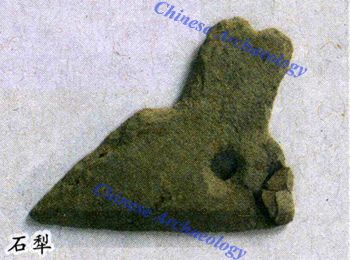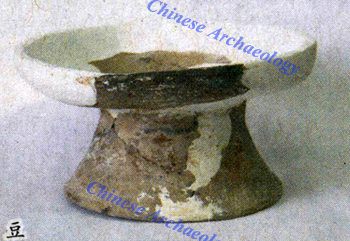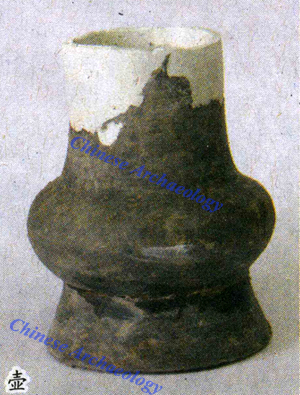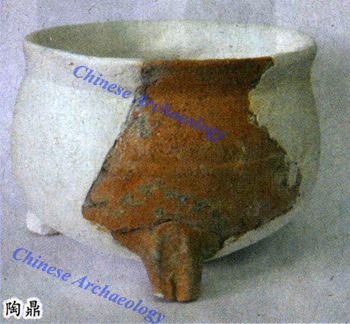First Discovery of Pre-Qin site in Middle-lower Wanjiang River
From:Chinese Archaeology NetWriter:Date:2014-06-23
Dachengzi site is located at Wuhu, Anhui Province where is seated a plain to the north of Yangtze River. It is on a platform 2m above the surface and its shape is almost ellipse in plan. The remaining top surface is 800 square meter while the bottom is 1000 square meter. A team from Anhui Provincial Institute of Archaeology and cultural relics conducted the excavation from January to June, 2013.
The excavation covers an area of 500 square meter, from which 3 burials, 1 architecture remain, 6 ash pits, 2 ash ditches, 1 burnt red clay pit, several post holes, a number of animal bones along with more than 160 artifacts dating back to the Neolithic period and the Zhou Dynasty. In addition, 14 burials of the Qing Dynasty and the later periods were recovered at the top layers.

unearthed stone plough-shaped tool
Neolithic remains were the main focus of the excavation. Discoveries include 1 burial, 1 ash pit, 1 burnt red clay deposit and several postholes. The burial M17 remains no traces of burial pit except one piece of burnt bone fragment, one black clay pot, one stone adze and one stone knife. The burnt red clay deposit occupies 5 square meters, the depth of which is 0.3m. Regarding their relatively big particle size, the burnt red clay could have been used for wall construction. Most of the postholes are round in plan with the diameters ranging from 20 to 50 cm. Yellowish soil was used to fill them however their distribution does not demonstrate a clear pattern.

unearthed pottery dou vessel
A variety of artifacts were found including jades, stone, and pottery. 5 jade awl-shaped wares are impressive, of which 2 remain entire. They are both slim and delicate in milky white or dark green color. Stone tools, namely adze, axe, knife, spade, and plough, are finely made though small in size. The pottery collection of cooking and serving vessels was excavated among which there are ding tripods and yan steamer, dou vessel (flat bowl with long stem), pot, dish, cup and lid. Large numbers of potsherds were found from cultural layers.

unearthed pottery hu vessel
Those assemblages date to the end of Late-Neolithic (5600-4300B.P.) according to the typology.
There are also rich data from the Zhou Dynasty. 1 architecture remain, 6 ash pits, 2 burials, 2 ash ditches, 1 burnt red clay deposits and several postholes were found.
Architecture F1 is composed of foundation groove and postholes. The foundation groove is 7.4m in length and 0.8m in width, extending from the north-west to the south-east. Most of the postholes distribute along both the inner and outer sides of the foundation groove. Another group of postholes are found situated next to the foundation whose relationship to the foundation has not yet been figured out. The postholes within the foundation are either round or ellipse in shape, with diameters varying from 15-60 cm and depth from 25-65 cm. The filling is grey-yellowish soil occasionally containing few potsherds.

unearthed pottery ding tripod
Three types of ash pits could be categorized according to their surface shape: round, ellipse and irregular. Both straight and curved wall types present. Two forms of their bottom shape were identified: they are flat and round bottoms.
All the ash ditches are bar-shaped with either straight or sloped wall.
The burnt red clay deposit concentrates within a round pit whose diameter and depth are 2.5m and 0.3m respectively. The filling contains considerable amounts of burnt red clay fragments and small quantity of potsherds.

unearthed jade awl-shaped pendant
A wide range of artifacts were found including stone tool, pottery, stamped hard ware, proto-porcelain and small bronze ware. Stone tools include adze, axe, spade, arrow, knife and grinding stone. Pottery assemblages embrace ding tripod, li (tripod cauldron), dou vessel, jar, bowl, pad, spindle whorl and so forth. Jar is the major ware in stamped hard ware assemblage whereas dou vessel dominate proto-porcelain collections. Bronze tools are generally small namely knife and arrowhead. There are also a large number of potsherds unearthed.
Judging from the features of artifacts, the majority of the collections belong to the middle or late periods of the Western Zhou dynasty while a small proportion of them date to early Spring and Autumn period.
Previous excavations of Neolithic and Shang periods’ settlements mainly focus in upper Wanjiang River valley and the southern bank of the middle-lower Wanjiang River. However, there is a striking lack of knowledge about the pre-Qin sites on the north bank of the middle-lower Wanjiang River. Dachengzi site is the first discovery of the Pre-Qin settlement in this region, which turns out to be the initial attempt to establish the regional archaeological sequence. Last but not least, the rich archaeological remains there prove some possibility to cast light on the mutual interaction between cultures during the Late-Neolithic and the Zhou Dynasty. Such issues concern the north-westwards expansion of the Liangzhu culture and the influences upon on south-east region imposed by West Zhou dynasty. (Translator: Dong Ningning)

